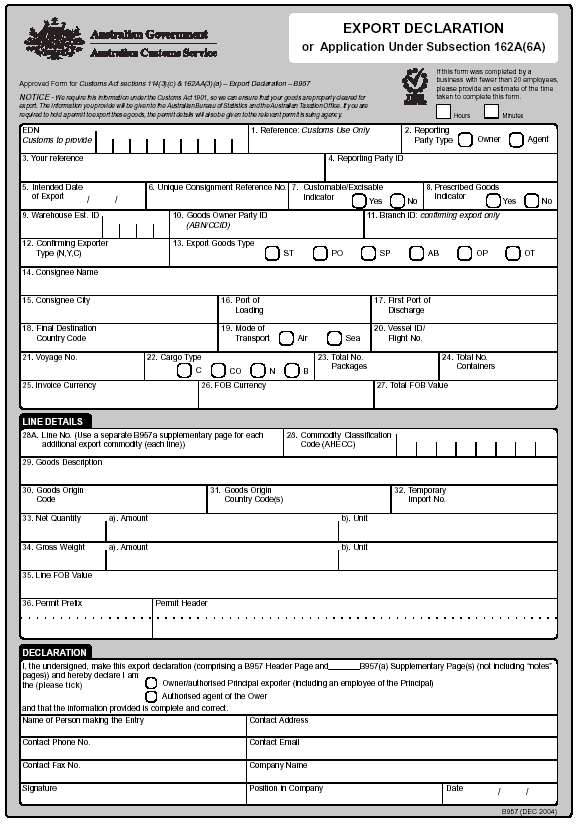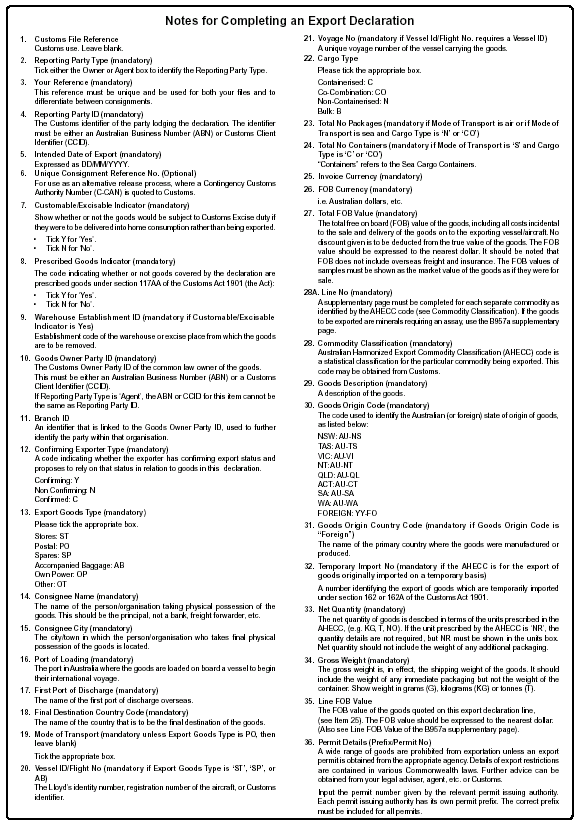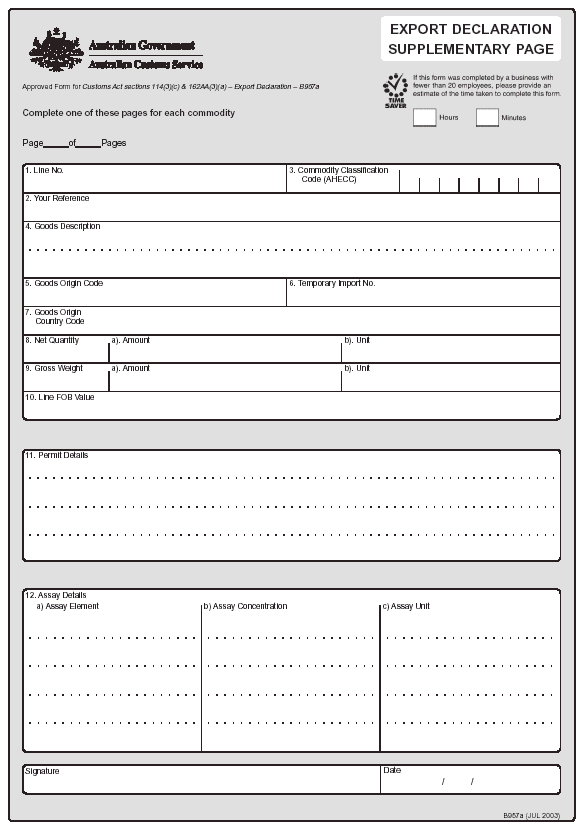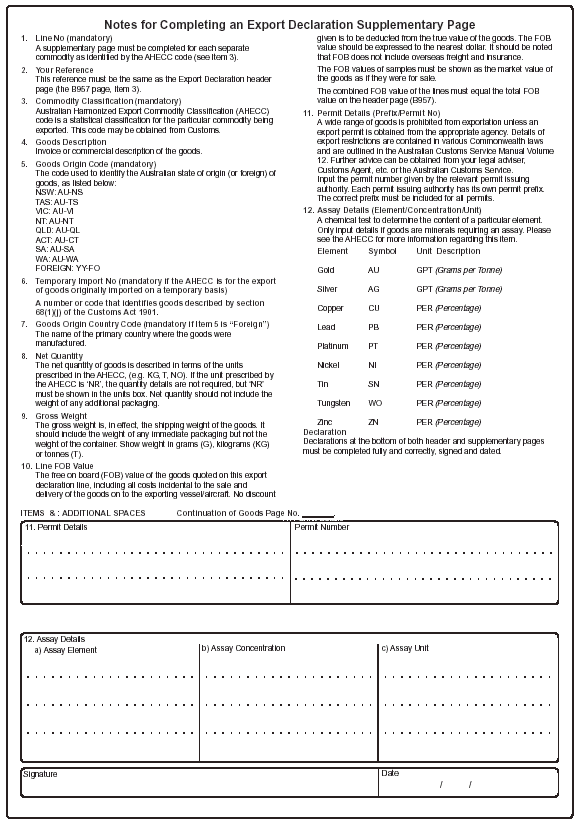|
|
The reporting of export details to the Australian Customs Service may be done:
- electronically, through the Integrated Cargo System (ICS); or
- by document, by completing the Export Declaration forms, B957, and if required, export declaration supplementary form B957a (for example, see end of Section of 1.5).
Exporters must report all export details prior to the goods being loaded on board the ship or aircraft transporting them out of Australia.
For assistance completing an export declaration please contact the Customs Information and Support Centre on 1300 363 263.
EVIDENCE OF IDENTITY
If the export declaration is made by document, then evidence of identity must be provided before the form can be accepted.
The evidence of identity check may be completed at an Australia Post KeyPOST outlet for a fee, or at a public counter at a Customs office.
A documentary export declaration will not be accepted by Customs except when received via Australia Post KeyPOST or at a Customs counter. Original declarations will not be accepted where faxed or mailed directly to Customs.
CLIENT REGISTRATION
Export declarations now require an identifier for both the reporting party (Reporting Party ID) and the owner of the goods (Goods owner party ID). These IDs will be either an Australian Business Number (ABN) or a Customs Client Identifier (CCID). The CCID is issued by Customs for those clients who do not have an ABN. The following clients will need to be registered with Customs before export declarations can be lodged:
- every business that reports directly to Customs;
- every exporter identified on an export declaration; and
- any individual, not part of an organisation/business, that reports directly to Customs.
EXEMPT GOODS
The following classes of goods are exempt from export declaration requirements, unless there is any permit required by Customs or other permit issuing authority prior to export:
- accompanied or unaccompanied personal or household effects of a passenger or crew member of an outgoing ship or aircraft, in reasonable quantities and not to be used in the course of trading outside Australia;
- goods included in a consignment that is consigned by post, by ship or by aircraft from one person to another person, and that has a value not exceeding the current threshold (currently $2,000).
This exemption does not apply to goods that are:
(a) dutiable goods where the duty is unpaid;
(b) excisable goods where the excise is unpaid; or
(c) goods for which a claim for drawback of Customs duty, excise duty or sales tax is intended.
- military goods which are the property of:
(a) Australian Defence Forces - military cargo which is the property of the Australian Defence Forces exported on ADF ships or aircraft from an ADF port or airport and which will not be sold or otherwise disposed of outside Australia; and
(b) Foreign Defence Forces - military goods which are for use in military exercises approved by the Australian Government and which have not been entered in an import entry;
- bags of mail (Australia Post or diplomatic);
- goods originating in one Australian port or airport moved on an international vessel or aircraft to another Australian port or airport without the intention to export;
- goods temporarily imported using a carnet;
- ship and aircraft spares for use only on an Australian owned vessel or aircraft; and
- containers or pallets that are the property of a person carrying on a business in Australia and which are exported on a temporary basis to be re-imported, whether they are empty or loaded.
AGGREGATION OF LINES
Where all the details of a group of transactions within the consignment, other than quantity, value and gross weight, are identical, the transactions may be aggregated to a single line.
INSTRUCTIONS FOR COMPLETING A DOCUMENTARY EXPORT DECLARATION (B957)
The following instructions are for the documentary export declaration (B957), but the information also applies to declarations lodged electronically using EDI or Customs Interactive. Commercial software packages may use different labels for some fields, and the layout of the fields is likely to vary.
Each of the following instructions relates to a field on the export declaration. The numbers shown beside the export declaration fields as shown below do not necessarily relate to the item numbers of the fields on an export declaration. Copies of the documentary export declaration forms are included at the end of this Section.
1. CUSTOMS FILE REFERENCE
Customs use. Leave blank for an original lodgement. If the declaration amends an earlier lodgement, then the Customs File Reference allocated by Customs may be shown here.
2. REPORTING PARTY TYPE (MANDATORY)
Whether the export declaration is made by the “owner” (including an employee of the owner) or by an authorised “agent” on behalf of the owner.
3. YOUR REFERENCE (MANDATORY)
Your reference (assigned by the person lodging the export declaration) must be unique and is used for both your files and to differentiate between consignments. For EXDOC clients, the EXDOC RFP number is automatically placed in this field in the ICS declaration.
4. REPORTING PARTY ID (MANDATORY)
The Customs identifier of the reporting party. The identifier must be either the Australian Business Number (ABN) or Customs Client Identifier (CCID).
5. INTENDED DATE OF EXPORT (MANDATORY)
The date on which is intended to export the consignment, expressed as DD/MM/YYYY.
6. UNIQUE CONSIGNMENT REFERENCE NUMBER
This is the exporter’s (Goods owner) unique reference.
If a contingency EDN (C-EDN) has been used as authority to export goods, the C-EDN must be shown here when the recovered export declaration is lodged.
7. CUSTOMABLE/EXCISABLE INDICATOR (MANDATORY)
Customable/Excisable Goods are goods which would be subject to customs or excise duty if they were to be delivered into home consumption rather than being exported. If the goods are customable/excisable, show “Y” in this field and show the establishment code of the warehouse from which the goods are to be removed in the Warehouse Establishment ID field. If goods are not customable/excisable goods show “N” in this field and leave the Warehouse Establishment ID field blank.
8. PRESCRIBED GOODS INDICATOR
Show “Y” if the consignment includes goods that are prescribed warehoused goods under sections 99 and 102A of the Customs Act 1901, that is, listed in Schedule 1AAA of the Customs Regulations 1958. If the consignment includes prescribed warehoused goods, then the establishment code of warehouse must be identified in the Warehouse Establishment ID field.
A list of AHECC codes for prescribed warehouse goods is shown at Section 1.6.3 Schedule 1AAA of the Customs Regulations - "Prescribed Warehouse Goods".
If the goods are not prescribed warehoused goods, indicate “N” whether or not there is unpaid customs or excise duty payable on the goods.
9. WAREHOUSE ESTABLISHMENT ID (MANDATORY IF CUSTOMABLE/EXCISABLE INDICATOR IS YES)
The establishment code of the warehouse from which the goods are to be removed for export.
The establishment code should be shown for all dutiable or excisable goods, whether or not the goods are prescribed warehoused goods.
10. GOODS OWNER PARTY ID (MANDATORY)
The Customs identifier of the common law owner of the goods. The identifier must be either the ABN or CCID under which the owner is registered.
If the export declaration is made by an agent on behalf of the owner, the ABN or CCID for this item cannot be the same as the Reporting Party ID.
11. BRANCH ID
An identifier, registered by Customs, that is linked to the Goods Owner Party ID, used to further identify the party within that organisation.
12. CONFIRMING EXPORTER TYPE (MANDATORY)
A code indicating whether the exporter has confirming export status and proposes to rely on that status in relation to goods in this declaration.
- A non-confirming (normal) declaration is shown as “N”.
- A confirming declaration (before exportation) is shown as “Y”.
- A confirmation (confirmed declaration) is shown as “C”.
13. EXPORTS GOODS TYPE (MANDATORY)
Indicate the type of export goods.
- ST: Stores - the goods are to be taken on board a ship or aircraft as stores.
- PO: Postal - the consignment is to be consigned by Australia Post.
- SP: Spares - the goods are to be taken on board a ship or aircraft as spares.
- AB: Accompanied Baggage - the consignment is to be exported as the accompanied baggage of a passenger.
- OP: Own Power - the goods will be exported under its own power.
- OT: Other - any goods that are not specified above.
14. CONSIGNEE NAME (MANDATORY)
The name of the person or organisation taking physical possession of the goods. This should be the principal, not a bank, freight forwarder, etc.
15. CONSIGNEE CITY (MANDATORY)
The city or town in which the person or organisation who takes final physical possession of the goods is located.
16. PORT OF LOADING (MANDATORY)
The Location Codes that are issued by the UN (UN/LOCODE) to identify a particular port in a country. In the ICS, the UN/LOCODE contains 5 characters, which consists of a two character country code (ie AU = Australia) and a three character port code (ie SYD = Sydney). These codes are not the same as the International Air Transport Authority (IATA) codes. The list of UN/LOCODEs can be found via the Internet from the Customs website or electronically in the ICS.
- For goods to be exported as sea cargo, the UN/LOCODE of the Australian port at which the goods are loaded onto the ship transporting them out of Australia.
- For goods to be exported as air cargo, the UN/LOCODE of the airport at which the goods are loaded onto the aircraft transporting them out of Australia.
- For goods that are repositioned within Australia prior to export, the UN/LOCODE of the port or airport where the goods are to be loaded onto the international carrier that is to export the goods from Australia. For example, goods accepted for export at Burnie and repositioned to Melbourne for subsequent export would show AUMEL.
17. FIRST PORT OF DISCHARGE (MANDATORY)
The UN/LOCODE of the first port of discharge overseas. This may not necessarily be the final destination of the goods.
If transshipment is to occur, this will be the first port or airport of discharge. For example, for goods exported to Kuwait via Singapore, the port of discharge will appear as "SGSIN" but the Country of Final Destination will appear as "KW".
18. FINAL DESTINATION COUNTRY CODE (MANDATORY)
The ISO3166/1 2-letter code for the country that is to be the final destination of the goods. Refer to Abbreviations and AHECC Summary, 2.5 Countries of Final Destination or Goods Origin Country Codes. This is the code for the country of final destination of the goods at the time of shipment. Do not enter the code for the Country where the goods are to be discharged for subsequent shipment to the country of final destination. For example, goods exported to Kuwait via Singapore should appear as "KW" not "SG".
19. MODE OF TRANSPORT (MANDATORY UNLESS GOODS ARE TO BE EXPORTED BY AUSTRALIA POST)
Indicate whether the consignment is to be exported by “Sea” or “Air”
20. VESSEL ID/FLIGHT NO (MANDATORY IF GOODS ARE STORES, SPARES OR ACCOMPANIED BAGGAGE)
The Lloyd’s identity number, registration number of the aircraft, or customs identifier.
21. VOYAGE NO (MANDATORY IF A VESSEL ID IS REQUIRED)
A unique voyage number of the ship carrying the stores, spares or accompanying baggage.
22. CARGO TYPE
Indicate the type of cargo.
- C: Containerised - the goods are to be exported as FCL sea cargo.
- CO: Combination - the goods are to be exported as a combination of FCL and LCL or non-containerised sea cargo.
- N: Non-Containerised - the goods are to be exported as LCL or non-containerised sea cargo, or as air cargo.
- B: Bulk - the goods are to be exported as a bulk commodity.
23. TOTAL NO PACKAGES
Mandatory if the goods are to be exported by air OR if the goods are to be exported by sea and the Cargo Type is non-containerised or combination.
24. TOTAL NO CONTAINERS
Mandatory if the Cargo Type is containerised or combination.
“Containers” refers to shipping containers.
25. INVOICE CURRENCY (MANDATORY)
The currency used on the invoice needs to be entered here. Refer to Abbreviations and AHECC Summary, 2.4 Invoice Currency Codes, for the codes that should be used.
26. FOB CURRENCY (MANDATORY)
If the invoice currency is listed in Abbreviations and AHECC Summary, 2.4 Invoice Currency Codes, (excluding OTH - All other currencies), then the FOB currency must be reported here in this currency. If not, then AUD should be reported.
27. TOTAL FOB VALUE (MANDATORY)
The total FOB value must be expressed in the currency specified in the FOB currency field and is the free on board value (or customs export value) of the goods, including all costs incidental to the sale and delivery of the goods on to the exporting vessel/aircraft. No discount given is to be deducted from the true value of the goods. The FOB value should be expressed to the nearest dollar. It should be noted that the export FOB value does not include overseas freight and insurance. The FOB values of samples must be shown as the market value of the goods as if they were for sale.
28A. LINE NO (MANDATORY)
A supplementary page must be completed for each separate commodity as identified by the AHECC code, refer to 28. Commodity Classification. If the goods to be exported are minerals requiring an assay, use the B957a supplementary page.
28. COMMODITY CLASSIFICATION (MANDATORY)
Input the classification code for the goods as specified in the AHECC manual. For details on the determination of the correct statistical item for a commodity, refer to Section 1.3 Classifying goods to the AHECC. If you experience difficulty in determining a classification, please contact the Customs AHECC Advisory Service by email aheccadvice@customs.gov.au or the Customs Information Centre on
1300 363 263.
The same AHECC may be input more than once. There is no need to consolidate lines with the same AHECC. Goods with the same AHECC but different export scheme or state of origin codes may be listed on up to 99 lines, where necessary.
29. GOODS DESCRIPTION (MANDATORY)
An accurate description of the goods.
30. GOODS ORIGIN CODE (MANDATORY)
The code used to identify the Australian (or foreign) state of origin of goods, as listed below:
 | AU-NS: | New South Wales; |
 | AU-VI: | Victoria; |
 | AU-QL: | Queensland; |
 | AU-SA: | South Australia; |
 | AU-WA: | Western Australia; |
 | AU-TS: | Tasmania; |
 | AU-NT: | Northern Territory; |
 | AU-CT: | Australian Capital Territory; and |
 | YY-FO: | Goods of foreign origin, re-exported. |
The following examples should assist in attributing the correct origin code.
- Minerals in ore and concentrate form (for example, iron ore and concentrate) should be attributed to the state or territory in which they were mined.
- Metals (for example, iron and steel ingots) should be attributed to the state or territory in which they were processed.
- Operations which leave the goods essentially unchanged (i.e. repair, blending, packaging, bottling, cleaning, sorting, husking and shelling) should not be considered as stages of production or manufacture.
- Goods which are imported and re-exported in the same condition as they arrive, or after undergoing repair or minor alteration (i.e. re-exports), should be shown as "YY-FO" indicating goods of foreign origin.
- Goods assembled from parts previously imported from overseas, where the end product does not resemble the component parts, should be attributed to the state or territory in which the assembly took place.
- Where a "raw" product is brought into Australia specifically for processing and re-export, the value added should be attributed to the state or territory of processing, whilst the "raw" input should be attributed to “YY-FO”.
For more information and treatment of more complex situations, please see Australian Customs Notice 2003/70 available on the Customs web site.
NOTE: If goods are excisable product, the origin should always be shown as Australian goods.
31. GOODS ORIGIN COUNTRY CODE (MANDATORY IF GOODS ORIGIN CODE IS “YY-FO”)
The ISO3166/1 2-letter code for the country where the goods were manufactured. For a list of the codes refer to Abbreviations and AHECC Summary, 2.5 Countries of Final Destination or Goods Origin Country Codes.
The new field requiring the identification of a foreign country code for export goods has been included on an export declaration to meet the new World Trade Organization (WTO) Agreement on Rules of Origin requirements, expected to be implemented in mid-2005 at the earliest. There are no current audit guidelines for the input of data into this field, but the information provided should not be misleading.
Until more detailed guidelines are issued for the use of this field, the country code known to be, or most likely to be the origin of the goods should be input. Where the goods are made up of several components from various foreign sources, the country code for the place where the goods were manufactured (that is, the place where the goods were formed through a process, or a series of processes, that changed the nature, commercial character and identity of its components) should be nominated. If the goods were not manufactured (for example, the goods are merely a collection of unassembled components), the country code for the place where the majority of the components were manufactured should be nominated.
It is expected that once the WTO origin requirements are finalised, those requirements will be published prior to implementation to assist industry determine the origin of the goods for the purposes of customs export declarations, as well as for other international trade purposes unrelated to the application of preferential duty rates.
The requirement for accurate information for the state of origin of domestically produced goods has not changed.
32. TEMPORARY IMPORT NO (MANDATORY IF AHECC is 9902.20.xx)
A number identifying the export of goods which are temporarily imported under sections 162 and 162A of the Customs Act 1901. The number is the “Full Import Declaration Number” assigned by Customs to the goods when they arrived in Australia with the intent of being subsequently exported.
33. NET QUANTITY (MANDATORY)
The net quantity of goods is described in terms of the units prescribed in the AHECC, (e.g. KG, T, NO). If the unit prescribed by the AHECC is ‘NR’, the quantity details are not required, but NR must be shown in the units box. Net quantity should not include the weight of any additional packaging.
34. GROSS WEIGHT (MANDATORY)
The gross weight is, in effect, the shipping weight of the goods. It should include the weight of any immediate packaging but not the weight of the container. Show weight in grams (G), kilograms (KG) or tonnes (T).
35. LINE FOB VALUE
The free on board (FOB) value (or customs export value) of the goods quoted on this export declaration line (see Item 27). The FOB value should be expressed to the nearest dollar or major currency unit.
36. PERMIT DETAILS (PREFIX/PERMIT NO)
A wide range of goods are prohibited from exportation unless an export permit is obtained from the appropriate agency. Details of export restrictions are contained in various Commonwealth laws and are outlined in the Australian Customs Service Manual Volume 12. Further advice can be obtained from your legal adviser, Customs Broker, etc. or Customs. Input the permit number given by the relevant permit issuing authority. Each permit issuing authority has its own permit prefix. The correct prefix must be included for all permits.
ASSAY DETAILS (ELEMENT/CONCENTRATION/UNIT) - ON EXPORT DECLARATION SUPPLEMENTARY FORM
A chemical test to determine the content of a particular element. Only input details if goods are minerals requiring an assay.
| Element | Symbol | Unit |
|
 |  |  |  |
| Gold | AU | GPT |
|
| Silver | AG | GPT |
|
| Copper | CU | PER |
|
| Lead | PB | PER |
|
| Platinum | PT | PER |
|
| Nickel | NI | PER |
|
| Tin | SN | PER |
|
| Tungsten | WO | PER |
|
| Zinc | ZN | PER |
|
DECLARATION (DOCUMENTARY DECLARATION ONLY)
This is a declaration by the person responsible for the export declaration, that the details reported are an accurate representation of the goods exported in this consignment.
Before signing, please ensure that all goods included in the consignment have been reported and that the export declaration has been completed accurately.
The full name of the person making the declaration and the date and place of issue should be included on the export declaration. The usual signature of that person is required.
EXPORT DECLARATION FORM (B957) and EXPORT DECLARATION SUPPLEMENTARY
FORM (B957(a))




|
 Print Page
Print Page